Implementing Humanitarian Interventions in Pakistan Flood Camps
VerifiedAdded on 2022/10/31
|21
|4343
|331
Project
AI Summary
This project proposal outlines a humanitarian intervention aimed at protecting the health and welfare of women, particularly focusing on menstrual hygiene management (MHM), in drought-affected regions of Pakistan. The rationale highlights the critical gaps in MHM support for women in emergency settings, emphasizing the challenges faced by displaced women and the importance of addressing their needs with dignity. The project proposes collaboration with key partner organizations like UNICEF and UNFPA, along with government ministries, CBOs, and local healthcare providers, to implement effective MHM strategies within IDP camps. The target group includes adolescent, young, and adult women (12-49 years old) from flood-affected areas, with a focus on improving their access to essential services, education, and support. The project's goal is to ensure menstruating women can manage their health in a sustainable, hygienic, and dignified manner, with specific objectives that include strengthening healthcare services, developing MHM monitoring tools, and educating the population. The project will use a five-stage innovation process, drawing from reports, academic journals, and toolkits, to implement and advocate for integrated MHM approaches. The project aims to address the critical needs of women in emergency settings and contribute to the achievement of relevant Sustainable Development Goals, with a focus on creating a supportive environment for improved MHM practices. The project aims to deliver strong and operational mediations that will capture requirements and requirements of the displaced females living in the camps after the catastrophic floods in KPK, Punjab and Sindh in Pakistan with consideration of ethnic practices, necessities for planning suitable mediations, delivery structures as well as Monitoring And Evaluation (M&E) tools.
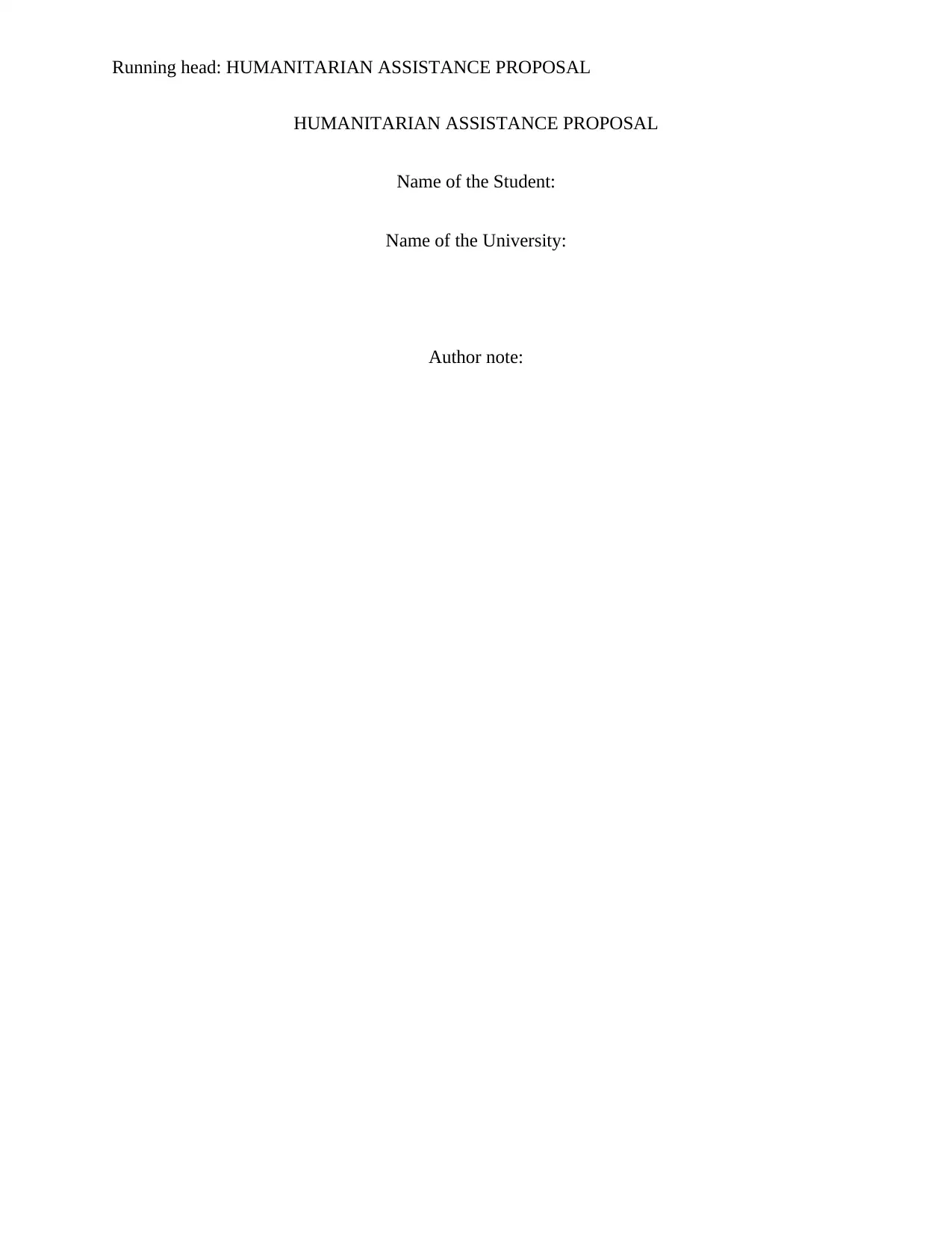
Running head: HUMANITARIAN ASSISTANCE PROPOSAL
HUMANITARIAN ASSISTANCE PROPOSAL
Name of the Student:
Name of the University:
Author note:
HUMANITARIAN ASSISTANCE PROPOSAL
Name of the Student:
Name of the University:
Author note:
Paraphrase This Document
Need a fresh take? Get an instant paraphrase of this document with our AI Paraphraser
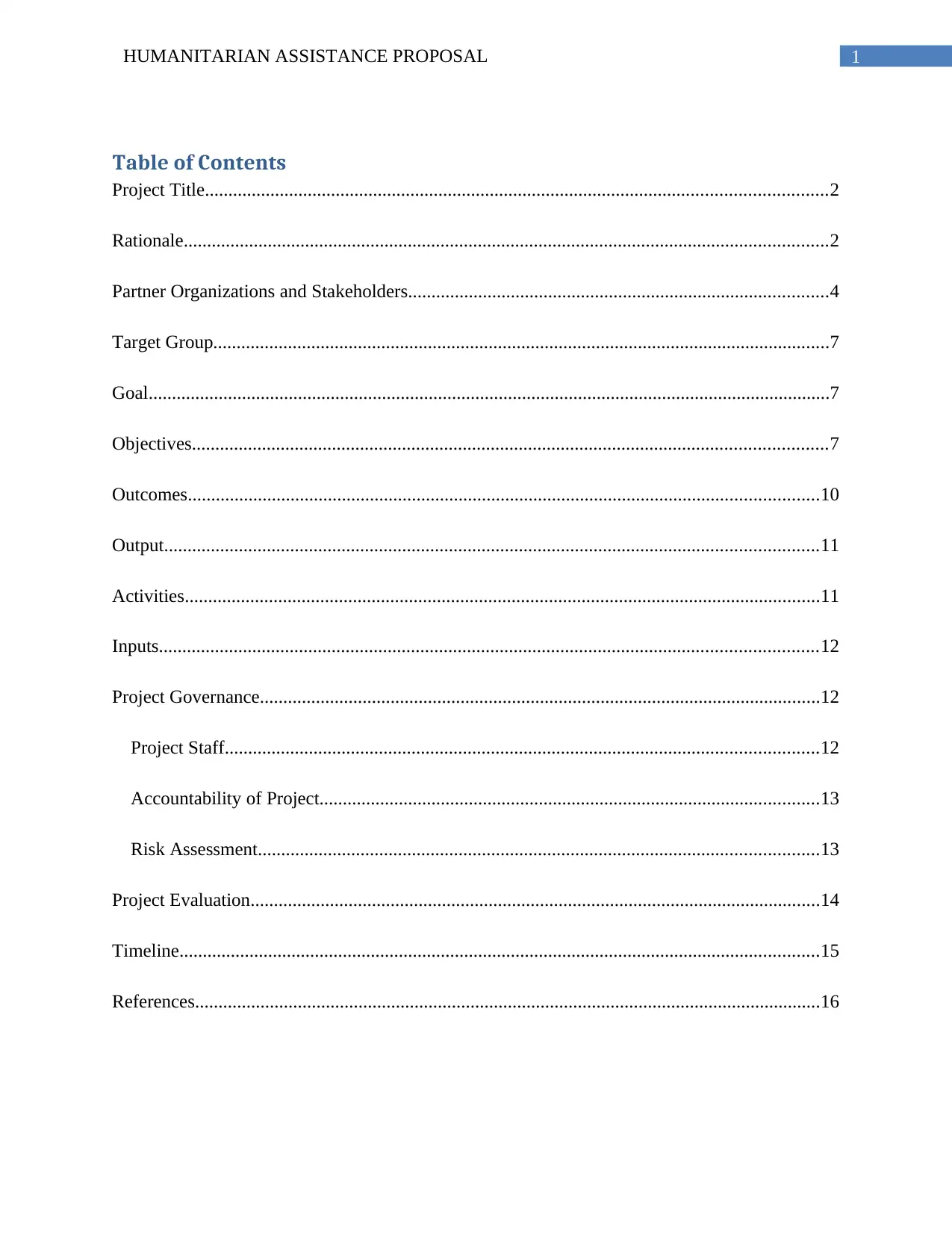
1HUMANITARIAN ASSISTANCE PROPOSAL
Table of Contents
Project Title.....................................................................................................................................2
Rationale..........................................................................................................................................2
Partner Organizations and Stakeholders..........................................................................................4
Target Group....................................................................................................................................7
Goal..................................................................................................................................................7
Objectives........................................................................................................................................7
Outcomes.......................................................................................................................................10
Output............................................................................................................................................11
Activities........................................................................................................................................11
Inputs.............................................................................................................................................12
Project Governance........................................................................................................................12
Project Staff...............................................................................................................................12
Accountability of Project...........................................................................................................13
Risk Assessment........................................................................................................................13
Project Evaluation..........................................................................................................................14
Timeline.........................................................................................................................................15
References......................................................................................................................................16
Table of Contents
Project Title.....................................................................................................................................2
Rationale..........................................................................................................................................2
Partner Organizations and Stakeholders..........................................................................................4
Target Group....................................................................................................................................7
Goal..................................................................................................................................................7
Objectives........................................................................................................................................7
Outcomes.......................................................................................................................................10
Output............................................................................................................................................11
Activities........................................................................................................................................11
Inputs.............................................................................................................................................12
Project Governance........................................................................................................................12
Project Staff...............................................................................................................................12
Accountability of Project...........................................................................................................13
Risk Assessment........................................................................................................................13
Project Evaluation..........................................................................................................................14
Timeline.........................................................................................................................................15
References......................................................................................................................................16
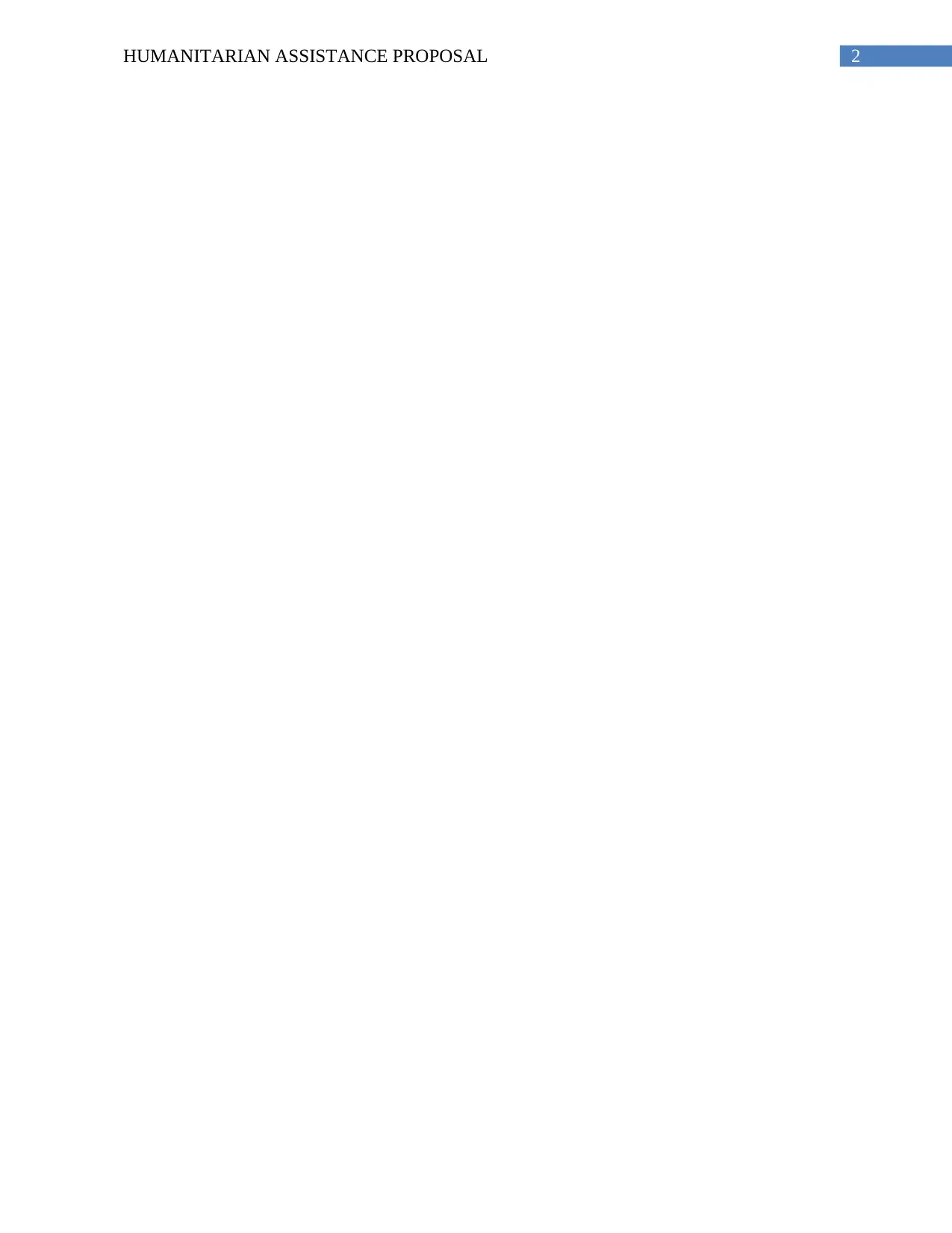
2HUMANITARIAN ASSISTANCE PROPOSAL
⊘ This is a preview!⊘
Do you want full access?
Subscribe today to unlock all pages.

Trusted by 1+ million students worldwide
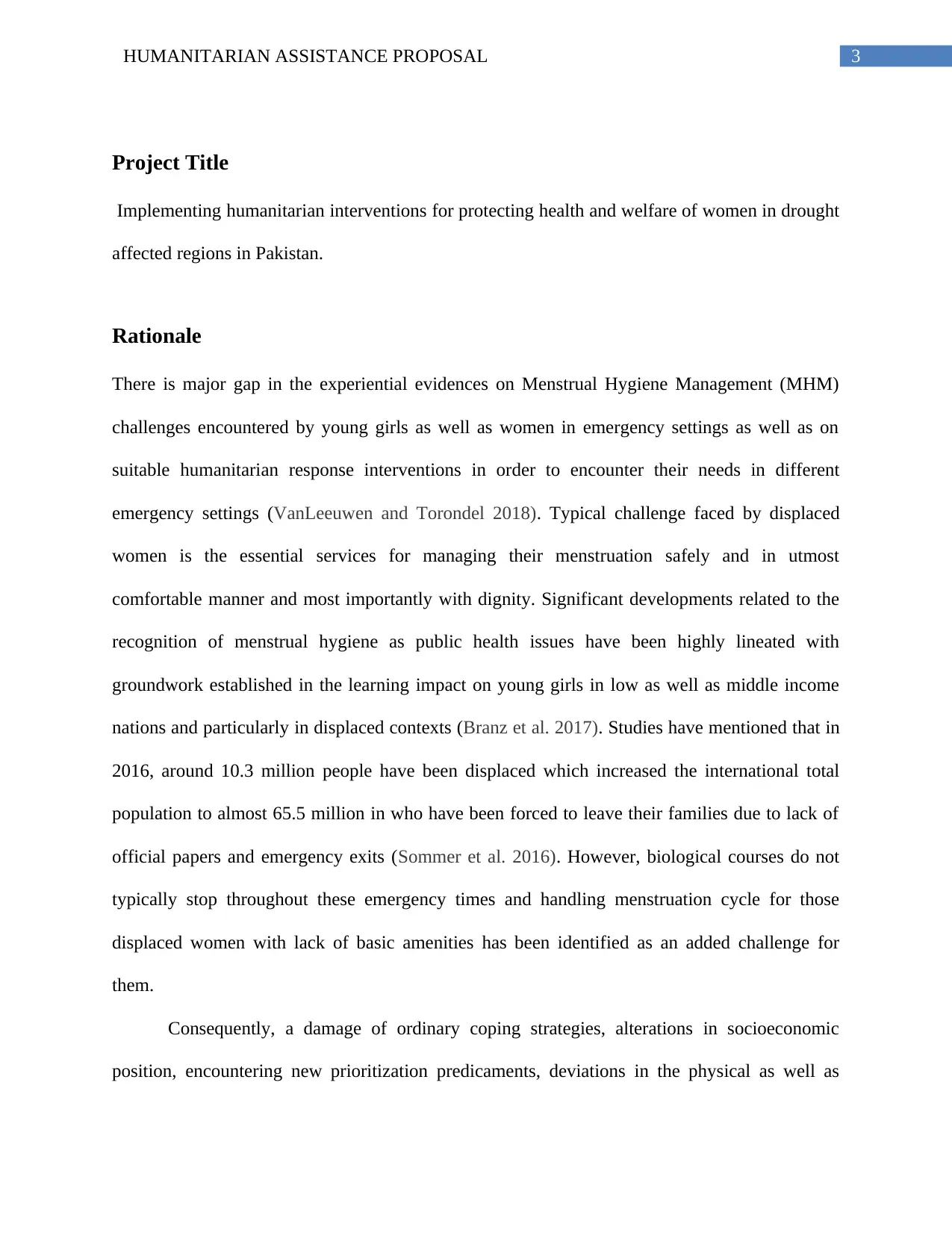
3HUMANITARIAN ASSISTANCE PROPOSAL
Project Title
Implementing humanitarian interventions for protecting health and welfare of women in drought
affected regions in Pakistan.
Rationale
There is major gap in the experiential evidences on Menstrual Hygiene Management (MHM)
challenges encountered by young girls as well as women in emergency settings as well as on
suitable humanitarian response interventions in order to encounter their needs in different
emergency settings (VanLeeuwen and Torondel 2018). Typical challenge faced by displaced
women is the essential services for managing their menstruation safely and in utmost
comfortable manner and most importantly with dignity. Significant developments related to the
recognition of menstrual hygiene as public health issues have been highly lineated with
groundwork established in the learning impact on young girls in low as well as middle income
nations and particularly in displaced contexts (Branz et al. 2017). Studies have mentioned that in
2016, around 10.3 million people have been displaced which increased the international total
population to almost 65.5 million in who have been forced to leave their families due to lack of
official papers and emergency exits (Sommer et al. 2016). However, biological courses do not
typically stop throughout these emergency times and handling menstruation cycle for those
displaced women with lack of basic amenities has been identified as an added challenge for
them.
Consequently, a damage of ordinary coping strategies, alterations in socioeconomic
position, encountering new prioritization predicaments, deviations in the physical as well as
Project Title
Implementing humanitarian interventions for protecting health and welfare of women in drought
affected regions in Pakistan.
Rationale
There is major gap in the experiential evidences on Menstrual Hygiene Management (MHM)
challenges encountered by young girls as well as women in emergency settings as well as on
suitable humanitarian response interventions in order to encounter their needs in different
emergency settings (VanLeeuwen and Torondel 2018). Typical challenge faced by displaced
women is the essential services for managing their menstruation safely and in utmost
comfortable manner and most importantly with dignity. Significant developments related to the
recognition of menstrual hygiene as public health issues have been highly lineated with
groundwork established in the learning impact on young girls in low as well as middle income
nations and particularly in displaced contexts (Branz et al. 2017). Studies have mentioned that in
2016, around 10.3 million people have been displaced which increased the international total
population to almost 65.5 million in who have been forced to leave their families due to lack of
official papers and emergency exits (Sommer et al. 2016). However, biological courses do not
typically stop throughout these emergency times and handling menstruation cycle for those
displaced women with lack of basic amenities has been identified as an added challenge for
them.
Consequently, a damage of ordinary coping strategies, alterations in socioeconomic
position, encountering new prioritization predicaments, deviations in the physical as well as
Paraphrase This Document
Need a fresh take? Get an instant paraphrase of this document with our AI Paraphraser
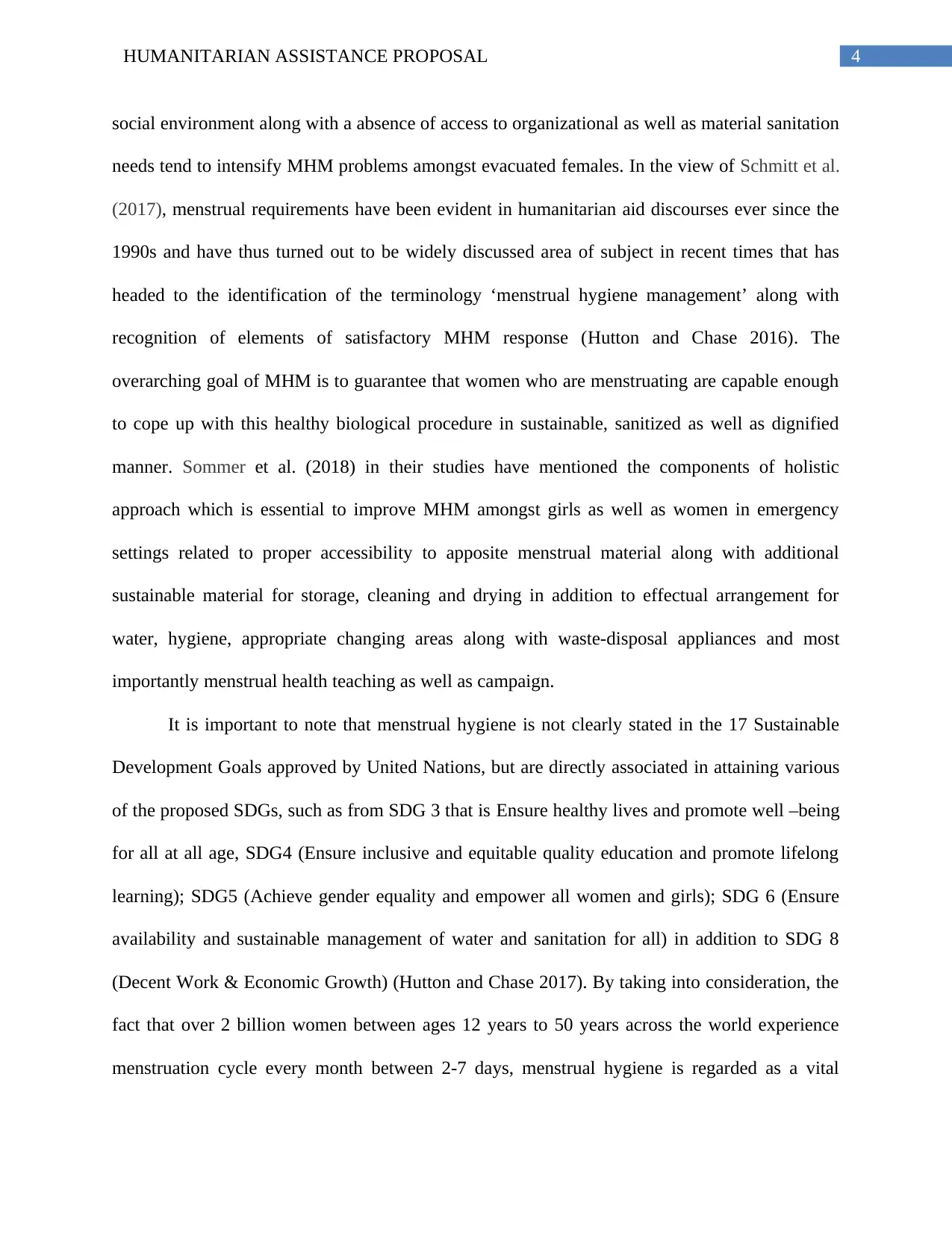
4HUMANITARIAN ASSISTANCE PROPOSAL
social environment along with a absence of access to organizational as well as material sanitation
needs tend to intensify MHM problems amongst evacuated females. In the view of Schmitt et al.
(2017), menstrual requirements have been evident in humanitarian aid discourses ever since the
1990s and have thus turned out to be widely discussed area of subject in recent times that has
headed to the identification of the terminology ‘menstrual hygiene management’ along with
recognition of elements of satisfactory MHM response (Hutton and Chase 2016). The
overarching goal of MHM is to guarantee that women who are menstruating are capable enough
to cope up with this healthy biological procedure in sustainable, sanitized as well as dignified
manner. Sommer et al. (2018) in their studies have mentioned the components of holistic
approach which is essential to improve MHM amongst girls as well as women in emergency
settings related to proper accessibility to apposite menstrual material along with additional
sustainable material for storage, cleaning and drying in addition to effectual arrangement for
water, hygiene, appropriate changing areas along with waste-disposal appliances and most
importantly menstrual health teaching as well as campaign.
It is important to note that menstrual hygiene is not clearly stated in the 17 Sustainable
Development Goals approved by United Nations, but are directly associated in attaining various
of the proposed SDGs, such as from SDG 3 that is Ensure healthy lives and promote well –being
for all at all age, SDG4 (Ensure inclusive and equitable quality education and promote lifelong
learning); SDG5 (Achieve gender equality and empower all women and girls); SDG 6 (Ensure
availability and sustainable management of water and sanitation for all) in addition to SDG 8
(Decent Work & Economic Growth) (Hutton and Chase 2017). By taking into consideration, the
fact that over 2 billion women between ages 12 years to 50 years across the world experience
menstruation cycle every month between 2-7 days, menstrual hygiene is regarded as a vital
social environment along with a absence of access to organizational as well as material sanitation
needs tend to intensify MHM problems amongst evacuated females. In the view of Schmitt et al.
(2017), menstrual requirements have been evident in humanitarian aid discourses ever since the
1990s and have thus turned out to be widely discussed area of subject in recent times that has
headed to the identification of the terminology ‘menstrual hygiene management’ along with
recognition of elements of satisfactory MHM response (Hutton and Chase 2016). The
overarching goal of MHM is to guarantee that women who are menstruating are capable enough
to cope up with this healthy biological procedure in sustainable, sanitized as well as dignified
manner. Sommer et al. (2018) in their studies have mentioned the components of holistic
approach which is essential to improve MHM amongst girls as well as women in emergency
settings related to proper accessibility to apposite menstrual material along with additional
sustainable material for storage, cleaning and drying in addition to effectual arrangement for
water, hygiene, appropriate changing areas along with waste-disposal appliances and most
importantly menstrual health teaching as well as campaign.
It is important to note that menstrual hygiene is not clearly stated in the 17 Sustainable
Development Goals approved by United Nations, but are directly associated in attaining various
of the proposed SDGs, such as from SDG 3 that is Ensure healthy lives and promote well –being
for all at all age, SDG4 (Ensure inclusive and equitable quality education and promote lifelong
learning); SDG5 (Achieve gender equality and empower all women and girls); SDG 6 (Ensure
availability and sustainable management of water and sanitation for all) in addition to SDG 8
(Decent Work & Economic Growth) (Hutton and Chase 2017). By taking into consideration, the
fact that over 2 billion women between ages 12 years to 50 years across the world experience
menstruation cycle every month between 2-7 days, menstrual hygiene is regarded as a vital
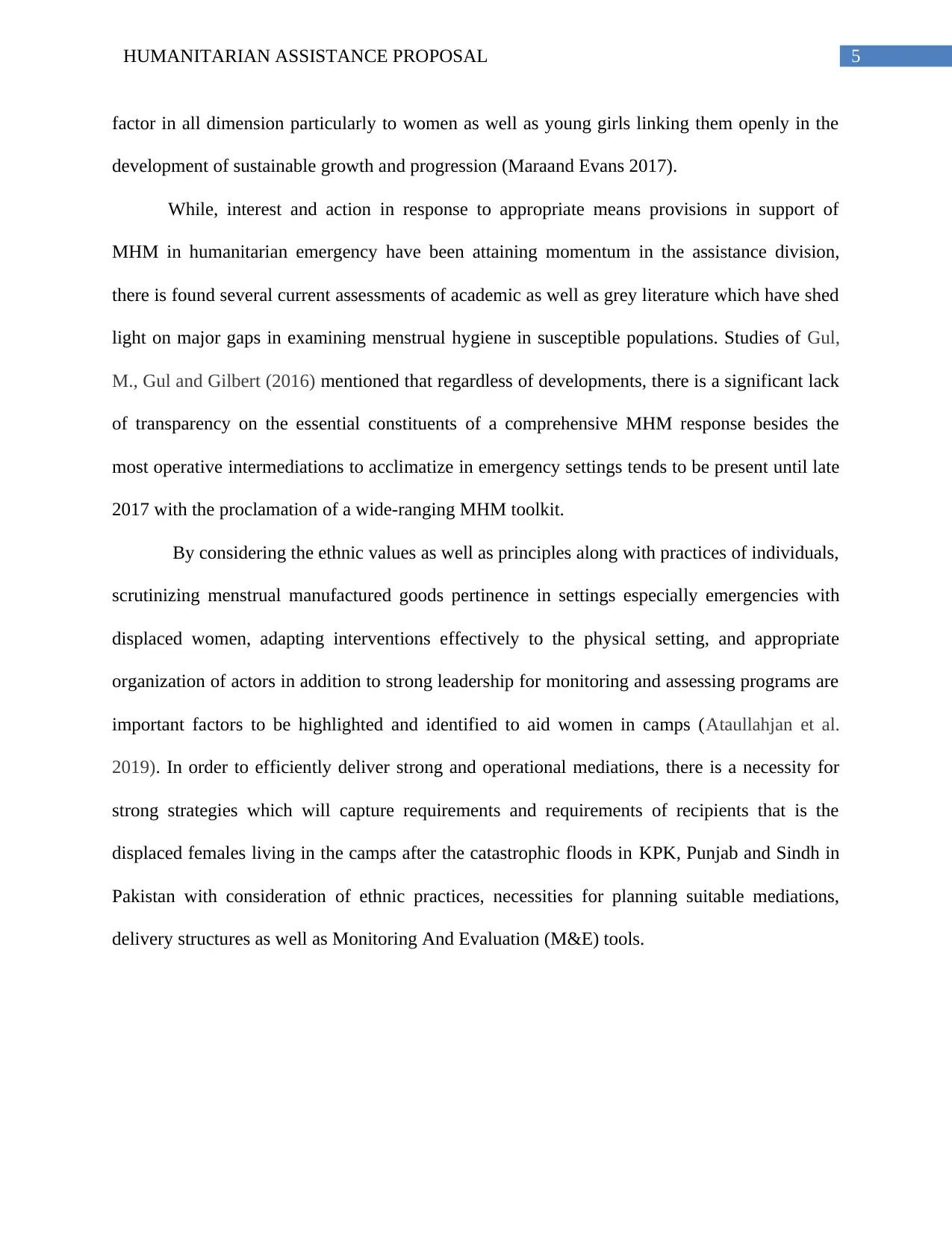
5HUMANITARIAN ASSISTANCE PROPOSAL
factor in all dimension particularly to women as well as young girls linking them openly in the
development of sustainable growth and progression (Maraand Evans 2017).
While, interest and action in response to appropriate means provisions in support of
MHM in humanitarian emergency have been attaining momentum in the assistance division,
there is found several current assessments of academic as well as grey literature which have shed
light on major gaps in examining menstrual hygiene in susceptible populations. Studies of Gul,
M., Gul and Gilbert (2016) mentioned that regardless of developments, there is a significant lack
of transparency on the essential constituents of a comprehensive MHM response besides the
most operative intermediations to acclimatize in emergency settings tends to be present until late
2017 with the proclamation of a wide-ranging MHM toolkit.
By considering the ethnic values as well as principles along with practices of individuals,
scrutinizing menstrual manufactured goods pertinence in settings especially emergencies with
displaced women, adapting interventions effectively to the physical setting, and appropriate
organization of actors in addition to strong leadership for monitoring and assessing programs are
important factors to be highlighted and identified to aid women in camps (Ataullahjan et al.
2019). In order to efficiently deliver strong and operational mediations, there is a necessity for
strong strategies which will capture requirements and requirements of recipients that is the
displaced females living in the camps after the catastrophic floods in KPK, Punjab and Sindh in
Pakistan with consideration of ethnic practices, necessities for planning suitable mediations,
delivery structures as well as Monitoring And Evaluation (M&E) tools.
factor in all dimension particularly to women as well as young girls linking them openly in the
development of sustainable growth and progression (Maraand Evans 2017).
While, interest and action in response to appropriate means provisions in support of
MHM in humanitarian emergency have been attaining momentum in the assistance division,
there is found several current assessments of academic as well as grey literature which have shed
light on major gaps in examining menstrual hygiene in susceptible populations. Studies of Gul,
M., Gul and Gilbert (2016) mentioned that regardless of developments, there is a significant lack
of transparency on the essential constituents of a comprehensive MHM response besides the
most operative intermediations to acclimatize in emergency settings tends to be present until late
2017 with the proclamation of a wide-ranging MHM toolkit.
By considering the ethnic values as well as principles along with practices of individuals,
scrutinizing menstrual manufactured goods pertinence in settings especially emergencies with
displaced women, adapting interventions effectively to the physical setting, and appropriate
organization of actors in addition to strong leadership for monitoring and assessing programs are
important factors to be highlighted and identified to aid women in camps (Ataullahjan et al.
2019). In order to efficiently deliver strong and operational mediations, there is a necessity for
strong strategies which will capture requirements and requirements of recipients that is the
displaced females living in the camps after the catastrophic floods in KPK, Punjab and Sindh in
Pakistan with consideration of ethnic practices, necessities for planning suitable mediations,
delivery structures as well as Monitoring And Evaluation (M&E) tools.
⊘ This is a preview!⊘
Do you want full access?
Subscribe today to unlock all pages.

Trusted by 1+ million students worldwide
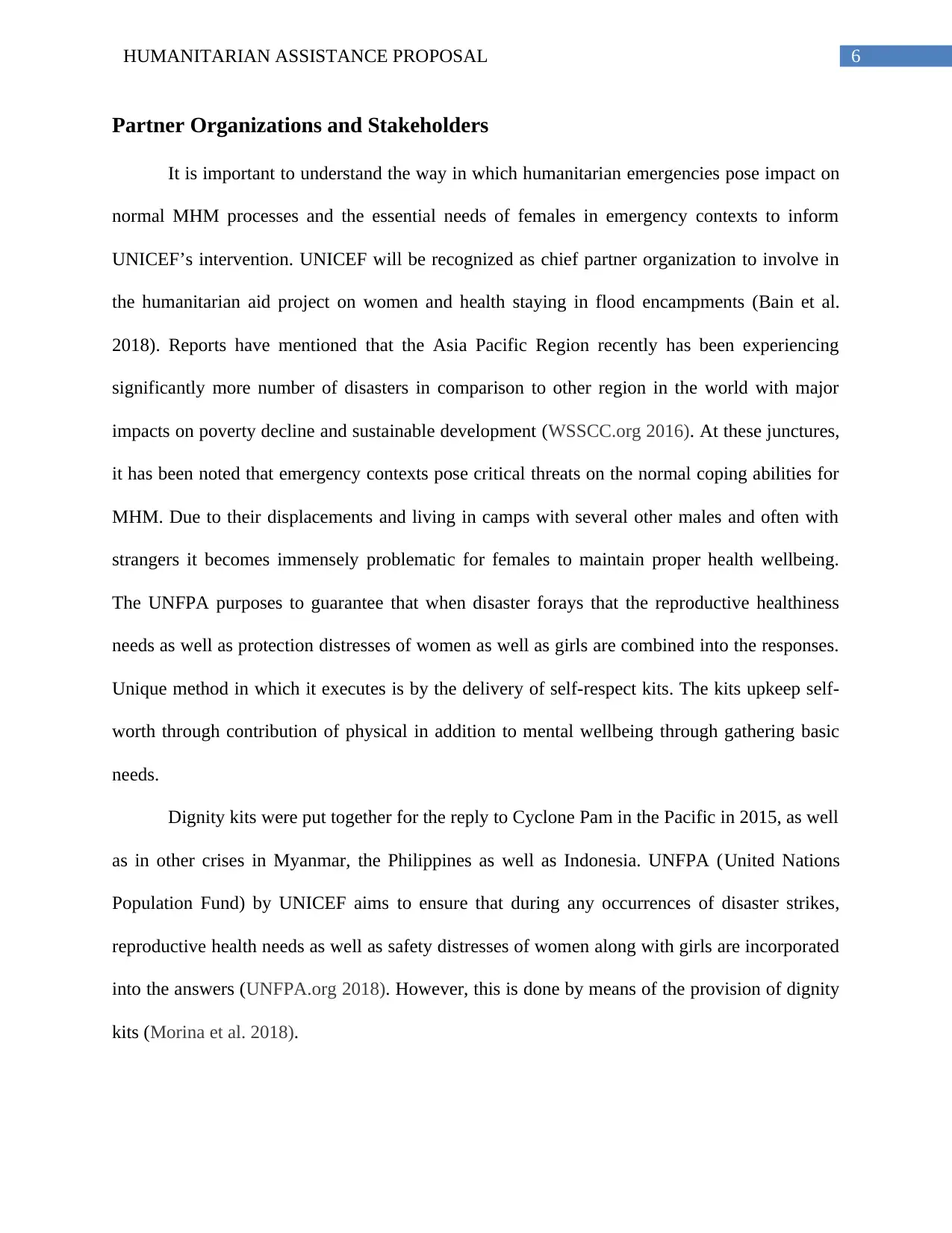
6HUMANITARIAN ASSISTANCE PROPOSAL
Partner Organizations and Stakeholders
It is important to understand the way in which humanitarian emergencies pose impact on
normal MHM processes and the essential needs of females in emergency contexts to inform
UNICEF’s intervention. UNICEF will be recognized as chief partner organization to involve in
the humanitarian aid project on women and health staying in flood encampments (Bain et al.
2018). Reports have mentioned that the Asia Pacific Region recently has been experiencing
significantly more number of disasters in comparison to other region in the world with major
impacts on poverty decline and sustainable development (WSSCC.org 2016). At these junctures,
it has been noted that emergency contexts pose critical threats on the normal coping abilities for
MHM. Due to their displacements and living in camps with several other males and often with
strangers it becomes immensely problematic for females to maintain proper health wellbeing.
The UNFPA purposes to guarantee that when disaster forays that the reproductive healthiness
needs as well as protection distresses of women as well as girls are combined into the responses.
Unique method in which it executes is by the delivery of self-respect kits. The kits upkeep self-
worth through contribution of physical in addition to mental wellbeing through gathering basic
needs.
Dignity kits were put together for the reply to Cyclone Pam in the Pacific in 2015, as well
as in other crises in Myanmar, the Philippines as well as Indonesia. UNFPA (United Nations
Population Fund) by UNICEF aims to ensure that during any occurrences of disaster strikes,
reproductive health needs as well as safety distresses of women along with girls are incorporated
into the answers (UNFPA.org 2018). However, this is done by means of the provision of dignity
kits (Morina et al. 2018).
Partner Organizations and Stakeholders
It is important to understand the way in which humanitarian emergencies pose impact on
normal MHM processes and the essential needs of females in emergency contexts to inform
UNICEF’s intervention. UNICEF will be recognized as chief partner organization to involve in
the humanitarian aid project on women and health staying in flood encampments (Bain et al.
2018). Reports have mentioned that the Asia Pacific Region recently has been experiencing
significantly more number of disasters in comparison to other region in the world with major
impacts on poverty decline and sustainable development (WSSCC.org 2016). At these junctures,
it has been noted that emergency contexts pose critical threats on the normal coping abilities for
MHM. Due to their displacements and living in camps with several other males and often with
strangers it becomes immensely problematic for females to maintain proper health wellbeing.
The UNFPA purposes to guarantee that when disaster forays that the reproductive healthiness
needs as well as protection distresses of women as well as girls are combined into the responses.
Unique method in which it executes is by the delivery of self-respect kits. The kits upkeep self-
worth through contribution of physical in addition to mental wellbeing through gathering basic
needs.
Dignity kits were put together for the reply to Cyclone Pam in the Pacific in 2015, as well
as in other crises in Myanmar, the Philippines as well as Indonesia. UNFPA (United Nations
Population Fund) by UNICEF aims to ensure that during any occurrences of disaster strikes,
reproductive health needs as well as safety distresses of women along with girls are incorporated
into the answers (UNFPA.org 2018). However, this is done by means of the provision of dignity
kits (Morina et al. 2018).
Paraphrase This Document
Need a fresh take? Get an instant paraphrase of this document with our AI Paraphraser
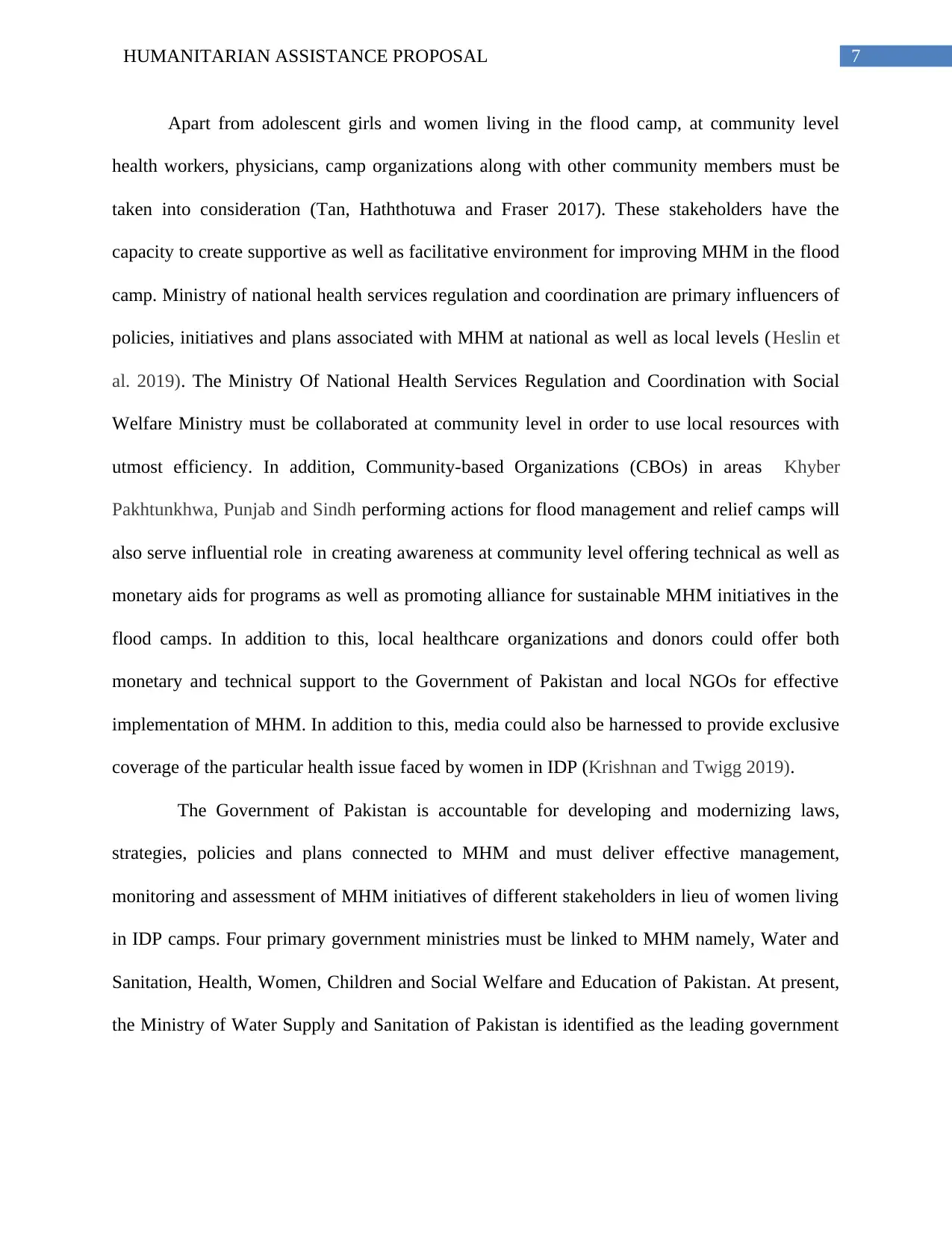
7HUMANITARIAN ASSISTANCE PROPOSAL
Apart from adolescent girls and women living in the flood camp, at community level
health workers, physicians, camp organizations along with other community members must be
taken into consideration (Tan, Haththotuwa and Fraser 2017). These stakeholders have the
capacity to create supportive as well as facilitative environment for improving MHM in the flood
camp. Ministry of national health services regulation and coordination are primary influencers of
policies, initiatives and plans associated with MHM at national as well as local levels (Heslin et
al. 2019). The Ministry Of National Health Services Regulation and Coordination with Social
Welfare Ministry must be collaborated at community level in order to use local resources with
utmost efficiency. In addition, Community-based Organizations (CBOs) in areas Khyber
Pakhtunkhwa, Punjab and Sindh performing actions for flood management and relief camps will
also serve influential role in creating awareness at community level offering technical as well as
monetary aids for programs as well as promoting alliance for sustainable MHM initiatives in the
flood camps. In addition to this, local healthcare organizations and donors could offer both
monetary and technical support to the Government of Pakistan and local NGOs for effective
implementation of MHM. In addition to this, media could also be harnessed to provide exclusive
coverage of the particular health issue faced by women in IDP (Krishnan and Twigg 2019).
The Government of Pakistan is accountable for developing and modernizing laws,
strategies, policies and plans connected to MHM and must deliver effective management,
monitoring and assessment of MHM initiatives of different stakeholders in lieu of women living
in IDP camps. Four primary government ministries must be linked to MHM namely, Water and
Sanitation, Health, Women, Children and Social Welfare and Education of Pakistan. At present,
the Ministry of Water Supply and Sanitation of Pakistan is identified as the leading government
Apart from adolescent girls and women living in the flood camp, at community level
health workers, physicians, camp organizations along with other community members must be
taken into consideration (Tan, Haththotuwa and Fraser 2017). These stakeholders have the
capacity to create supportive as well as facilitative environment for improving MHM in the flood
camp. Ministry of national health services regulation and coordination are primary influencers of
policies, initiatives and plans associated with MHM at national as well as local levels (Heslin et
al. 2019). The Ministry Of National Health Services Regulation and Coordination with Social
Welfare Ministry must be collaborated at community level in order to use local resources with
utmost efficiency. In addition, Community-based Organizations (CBOs) in areas Khyber
Pakhtunkhwa, Punjab and Sindh performing actions for flood management and relief camps will
also serve influential role in creating awareness at community level offering technical as well as
monetary aids for programs as well as promoting alliance for sustainable MHM initiatives in the
flood camps. In addition to this, local healthcare organizations and donors could offer both
monetary and technical support to the Government of Pakistan and local NGOs for effective
implementation of MHM. In addition to this, media could also be harnessed to provide exclusive
coverage of the particular health issue faced by women in IDP (Krishnan and Twigg 2019).
The Government of Pakistan is accountable for developing and modernizing laws,
strategies, policies and plans connected to MHM and must deliver effective management,
monitoring and assessment of MHM initiatives of different stakeholders in lieu of women living
in IDP camps. Four primary government ministries must be linked to MHM namely, Water and
Sanitation, Health, Women, Children and Social Welfare and Education of Pakistan. At present,
the Ministry of Water Supply and Sanitation of Pakistan is identified as the leading government
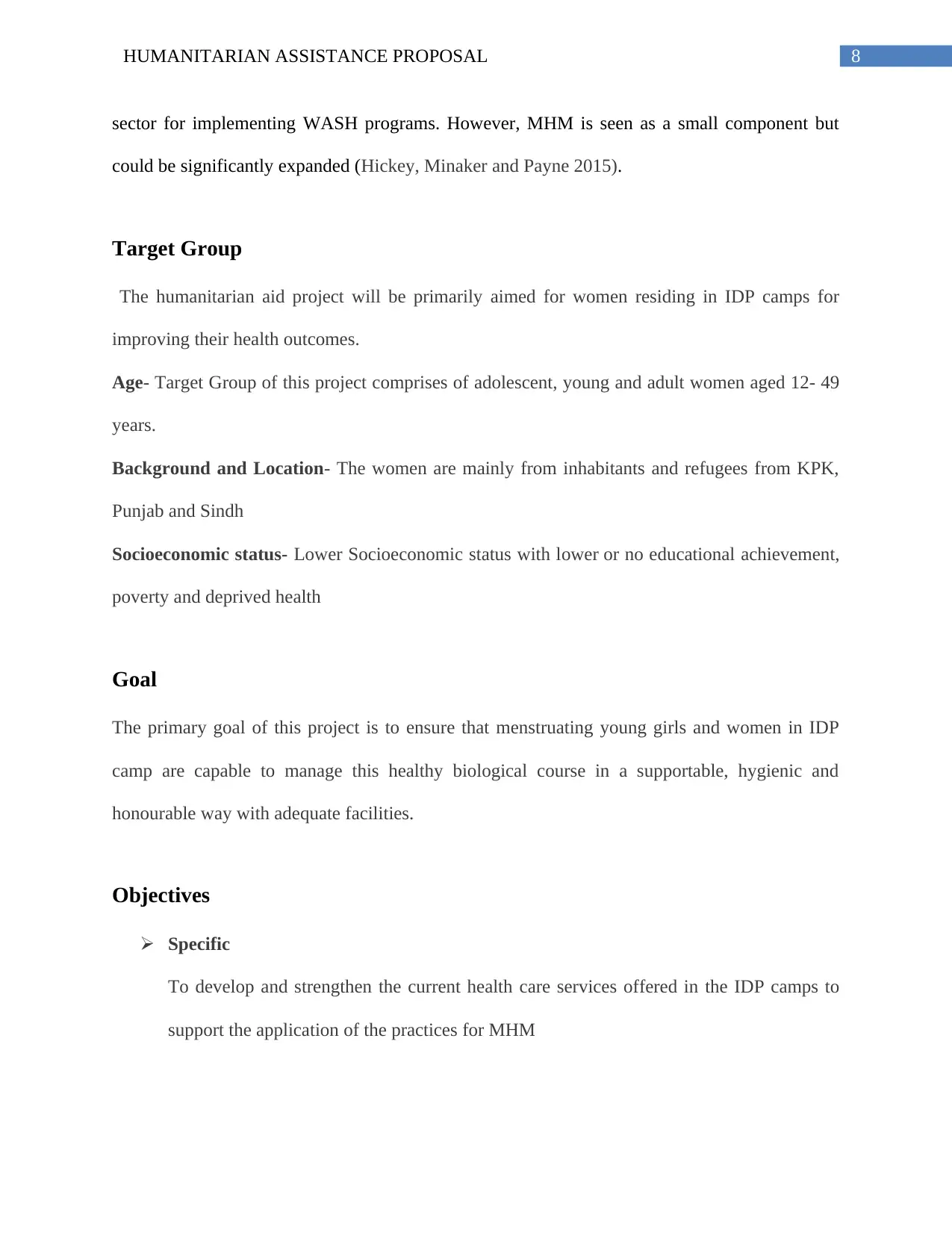
8HUMANITARIAN ASSISTANCE PROPOSAL
sector for implementing WASH programs. However, MHM is seen as a small component but
could be significantly expanded (Hickey, Minaker and Payne 2015).
Target Group
The humanitarian aid project will be primarily aimed for women residing in IDP camps for
improving their health outcomes.
Age- Target Group of this project comprises of adolescent, young and adult women aged 12- 49
years.
Background and Location- The women are mainly from inhabitants and refugees from KPK,
Punjab and Sindh
Socioeconomic status- Lower Socioeconomic status with lower or no educational achievement,
poverty and deprived health
Goal
The primary goal of this project is to ensure that menstruating young girls and women in IDP
camp are capable to manage this healthy biological course in a supportable, hygienic and
honourable way with adequate facilities.
Objectives
Specific
To develop and strengthen the current health care services offered in the IDP camps to
support the application of the practices for MHM
sector for implementing WASH programs. However, MHM is seen as a small component but
could be significantly expanded (Hickey, Minaker and Payne 2015).
Target Group
The humanitarian aid project will be primarily aimed for women residing in IDP camps for
improving their health outcomes.
Age- Target Group of this project comprises of adolescent, young and adult women aged 12- 49
years.
Background and Location- The women are mainly from inhabitants and refugees from KPK,
Punjab and Sindh
Socioeconomic status- Lower Socioeconomic status with lower or no educational achievement,
poverty and deprived health
Goal
The primary goal of this project is to ensure that menstruating young girls and women in IDP
camp are capable to manage this healthy biological course in a supportable, hygienic and
honourable way with adequate facilities.
Objectives
Specific
To develop and strengthen the current health care services offered in the IDP camps to
support the application of the practices for MHM
⊘ This is a preview!⊘
Do you want full access?
Subscribe today to unlock all pages.

Trusted by 1+ million students worldwide
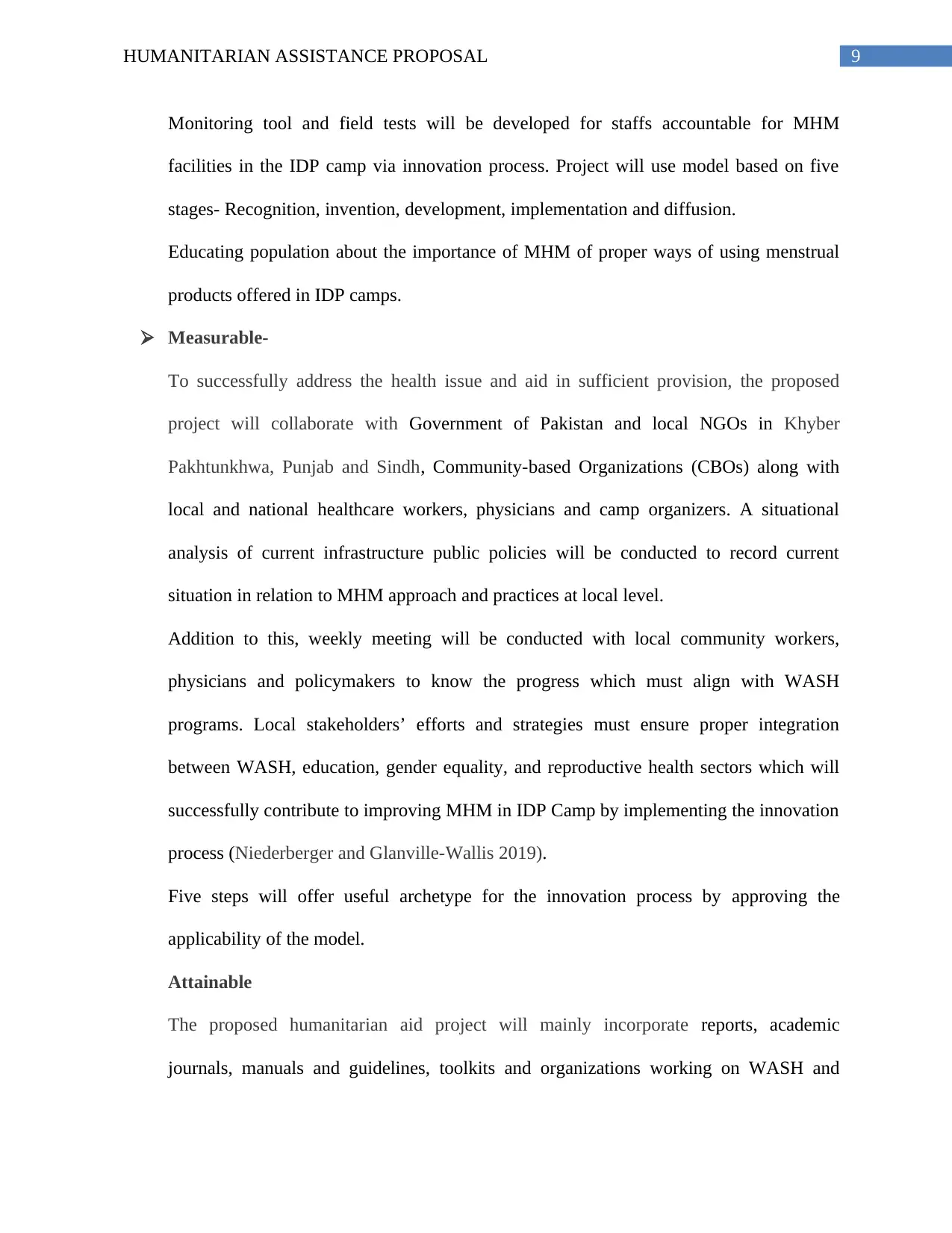
9HUMANITARIAN ASSISTANCE PROPOSAL
Monitoring tool and field tests will be developed for staffs accountable for MHM
facilities in the IDP camp via innovation process. Project will use model based on five
stages- Recognition, invention, development, implementation and diffusion.
Educating population about the importance of MHM of proper ways of using menstrual
products offered in IDP camps.
Measurable-
To successfully address the health issue and aid in sufficient provision, the proposed
project will collaborate with Government of Pakistan and local NGOs in Khyber
Pakhtunkhwa, Punjab and Sindh, Community-based Organizations (CBOs) along with
local and national healthcare workers, physicians and camp organizers. A situational
analysis of current infrastructure public policies will be conducted to record current
situation in relation to MHM approach and practices at local level.
Addition to this, weekly meeting will be conducted with local community workers,
physicians and policymakers to know the progress which must align with WASH
programs. Local stakeholders’ efforts and strategies must ensure proper integration
between WASH, education, gender equality, and reproductive health sectors which will
successfully contribute to improving MHM in IDP Camp by implementing the innovation
process (Niederberger and Glanville-Wallis 2019).
Five steps will offer useful archetype for the innovation process by approving the
applicability of the model.
Attainable
The proposed humanitarian aid project will mainly incorporate reports, academic
journals, manuals and guidelines, toolkits and organizations working on WASH and
Monitoring tool and field tests will be developed for staffs accountable for MHM
facilities in the IDP camp via innovation process. Project will use model based on five
stages- Recognition, invention, development, implementation and diffusion.
Educating population about the importance of MHM of proper ways of using menstrual
products offered in IDP camps.
Measurable-
To successfully address the health issue and aid in sufficient provision, the proposed
project will collaborate with Government of Pakistan and local NGOs in Khyber
Pakhtunkhwa, Punjab and Sindh, Community-based Organizations (CBOs) along with
local and national healthcare workers, physicians and camp organizers. A situational
analysis of current infrastructure public policies will be conducted to record current
situation in relation to MHM approach and practices at local level.
Addition to this, weekly meeting will be conducted with local community workers,
physicians and policymakers to know the progress which must align with WASH
programs. Local stakeholders’ efforts and strategies must ensure proper integration
between WASH, education, gender equality, and reproductive health sectors which will
successfully contribute to improving MHM in IDP Camp by implementing the innovation
process (Niederberger and Glanville-Wallis 2019).
Five steps will offer useful archetype for the innovation process by approving the
applicability of the model.
Attainable
The proposed humanitarian aid project will mainly incorporate reports, academic
journals, manuals and guidelines, toolkits and organizations working on WASH and
Paraphrase This Document
Need a fresh take? Get an instant paraphrase of this document with our AI Paraphraser
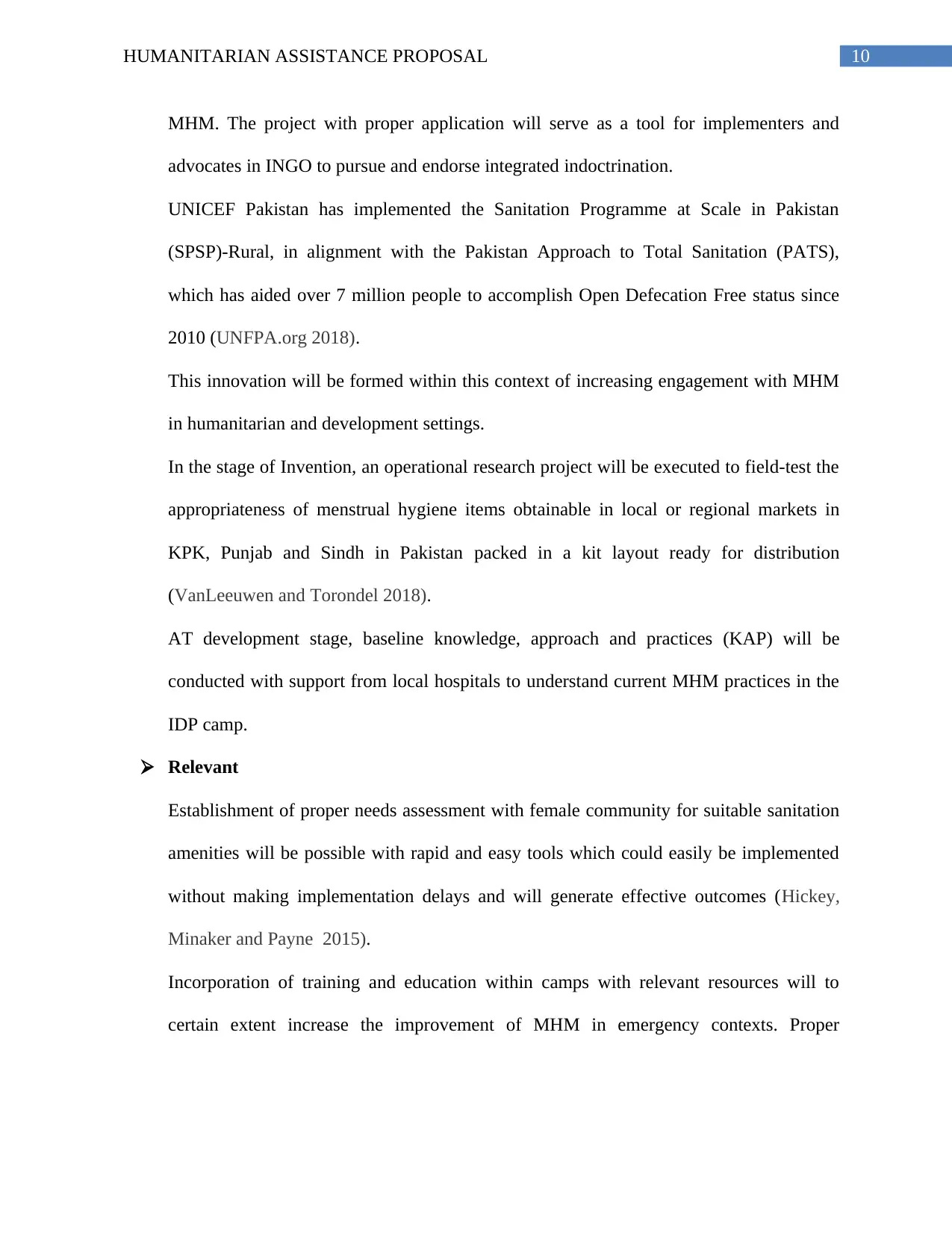
10HUMANITARIAN ASSISTANCE PROPOSAL
MHM. The project with proper application will serve as a tool for implementers and
advocates in INGO to pursue and endorse integrated indoctrination.
UNICEF Pakistan has implemented the Sanitation Programme at Scale in Pakistan
(SPSP)-Rural, in alignment with the Pakistan Approach to Total Sanitation (PATS),
which has aided over 7 million people to accomplish Open Defecation Free status since
2010 (UNFPA.org 2018).
This innovation will be formed within this context of increasing engagement with MHM
in humanitarian and development settings.
In the stage of Invention, an operational research project will be executed to field-test the
appropriateness of menstrual hygiene items obtainable in local or regional markets in
KPK, Punjab and Sindh in Pakistan packed in a kit layout ready for distribution
(VanLeeuwen and Torondel 2018).
AT development stage, baseline knowledge, approach and practices (KAP) will be
conducted with support from local hospitals to understand current MHM practices in the
IDP camp.
Relevant
Establishment of proper needs assessment with female community for suitable sanitation
amenities will be possible with rapid and easy tools which could easily be implemented
without making implementation delays and will generate effective outcomes (Hickey,
Minaker and Payne 2015).
Incorporation of training and education within camps with relevant resources will to
certain extent increase the improvement of MHM in emergency contexts. Proper
MHM. The project with proper application will serve as a tool for implementers and
advocates in INGO to pursue and endorse integrated indoctrination.
UNICEF Pakistan has implemented the Sanitation Programme at Scale in Pakistan
(SPSP)-Rural, in alignment with the Pakistan Approach to Total Sanitation (PATS),
which has aided over 7 million people to accomplish Open Defecation Free status since
2010 (UNFPA.org 2018).
This innovation will be formed within this context of increasing engagement with MHM
in humanitarian and development settings.
In the stage of Invention, an operational research project will be executed to field-test the
appropriateness of menstrual hygiene items obtainable in local or regional markets in
KPK, Punjab and Sindh in Pakistan packed in a kit layout ready for distribution
(VanLeeuwen and Torondel 2018).
AT development stage, baseline knowledge, approach and practices (KAP) will be
conducted with support from local hospitals to understand current MHM practices in the
IDP camp.
Relevant
Establishment of proper needs assessment with female community for suitable sanitation
amenities will be possible with rapid and easy tools which could easily be implemented
without making implementation delays and will generate effective outcomes (Hickey,
Minaker and Payne 2015).
Incorporation of training and education within camps with relevant resources will to
certain extent increase the improvement of MHM in emergency contexts. Proper
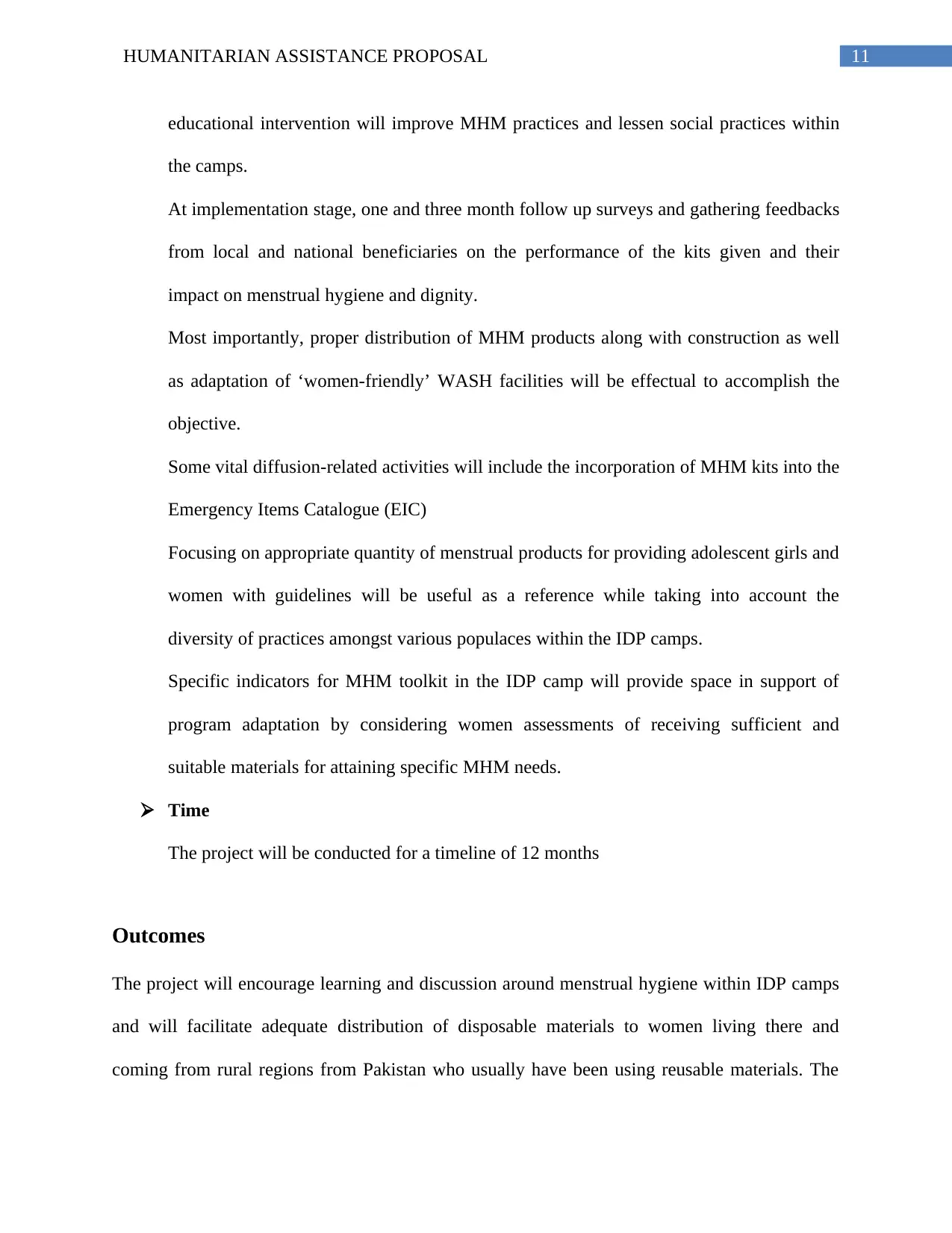
11HUMANITARIAN ASSISTANCE PROPOSAL
educational intervention will improve MHM practices and lessen social practices within
the camps.
At implementation stage, one and three month follow up surveys and gathering feedbacks
from local and national beneficiaries on the performance of the kits given and their
impact on menstrual hygiene and dignity.
Most importantly, proper distribution of MHM products along with construction as well
as adaptation of ‘women-friendly’ WASH facilities will be effectual to accomplish the
objective.
Some vital diffusion-related activities will include the incorporation of MHM kits into the
Emergency Items Catalogue (EIC)
Focusing on appropriate quantity of menstrual products for providing adolescent girls and
women with guidelines will be useful as a reference while taking into account the
diversity of practices amongst various populaces within the IDP camps.
Specific indicators for MHM toolkit in the IDP camp will provide space in support of
program adaptation by considering women assessments of receiving sufficient and
suitable materials for attaining specific MHM needs.
Time
The project will be conducted for a timeline of 12 months
Outcomes
The project will encourage learning and discussion around menstrual hygiene within IDP camps
and will facilitate adequate distribution of disposable materials to women living there and
coming from rural regions from Pakistan who usually have been using reusable materials. The
educational intervention will improve MHM practices and lessen social practices within
the camps.
At implementation stage, one and three month follow up surveys and gathering feedbacks
from local and national beneficiaries on the performance of the kits given and their
impact on menstrual hygiene and dignity.
Most importantly, proper distribution of MHM products along with construction as well
as adaptation of ‘women-friendly’ WASH facilities will be effectual to accomplish the
objective.
Some vital diffusion-related activities will include the incorporation of MHM kits into the
Emergency Items Catalogue (EIC)
Focusing on appropriate quantity of menstrual products for providing adolescent girls and
women with guidelines will be useful as a reference while taking into account the
diversity of practices amongst various populaces within the IDP camps.
Specific indicators for MHM toolkit in the IDP camp will provide space in support of
program adaptation by considering women assessments of receiving sufficient and
suitable materials for attaining specific MHM needs.
Time
The project will be conducted for a timeline of 12 months
Outcomes
The project will encourage learning and discussion around menstrual hygiene within IDP camps
and will facilitate adequate distribution of disposable materials to women living there and
coming from rural regions from Pakistan who usually have been using reusable materials. The
⊘ This is a preview!⊘
Do you want full access?
Subscribe today to unlock all pages.

Trusted by 1+ million students worldwide
1 out of 21
Your All-in-One AI-Powered Toolkit for Academic Success.
+13062052269
info@desklib.com
Available 24*7 on WhatsApp / Email
![[object Object]](/_next/static/media/star-bottom.7253800d.svg)
Unlock your academic potential
Copyright © 2020–2025 A2Z Services. All Rights Reserved. Developed and managed by ZUCOL.
